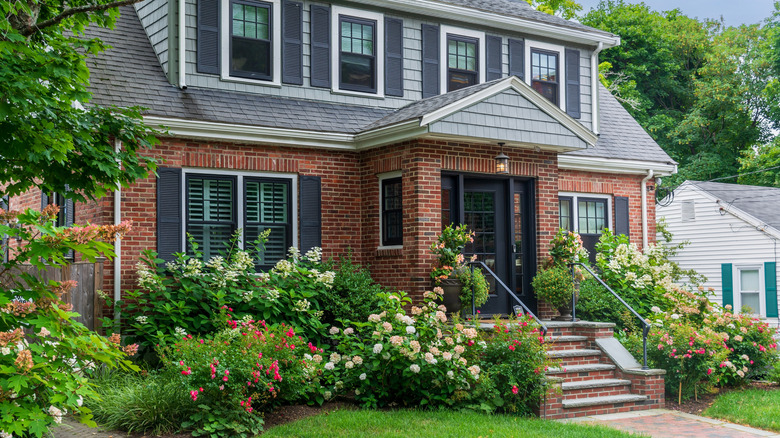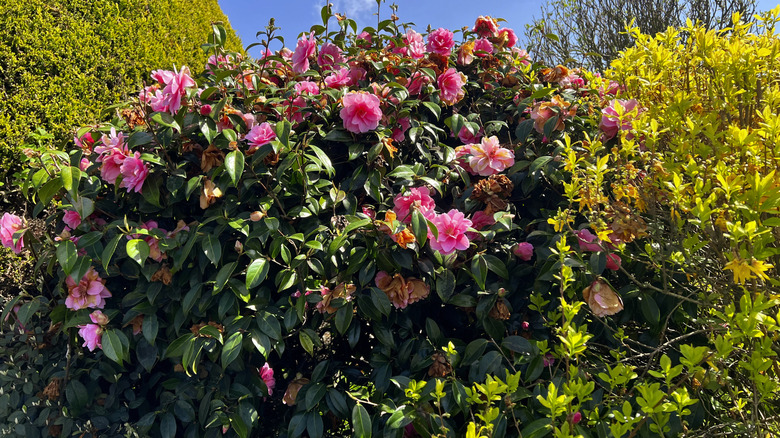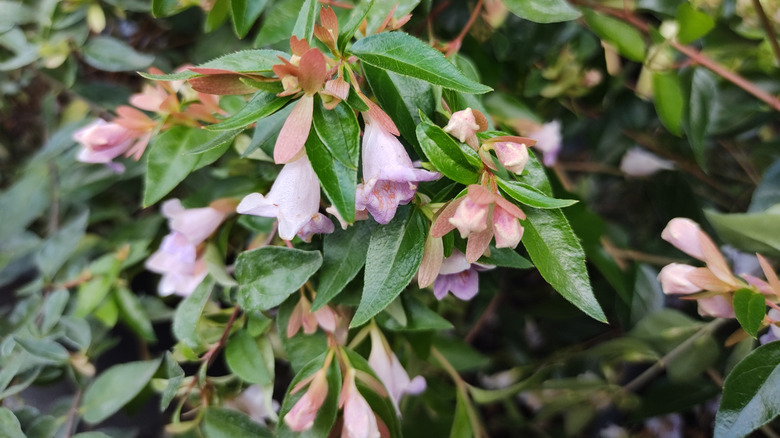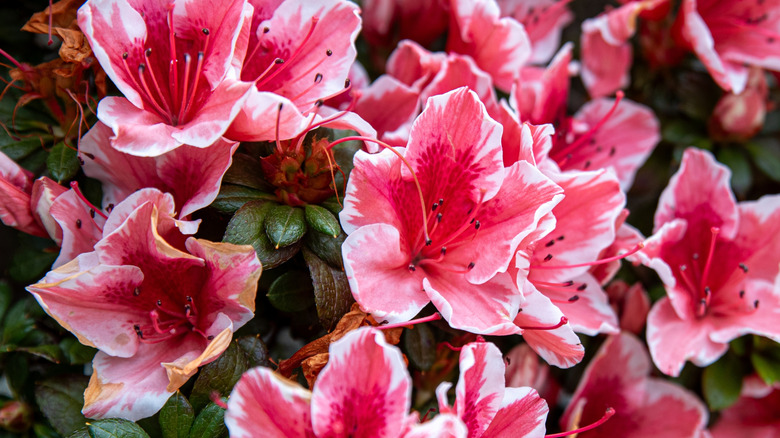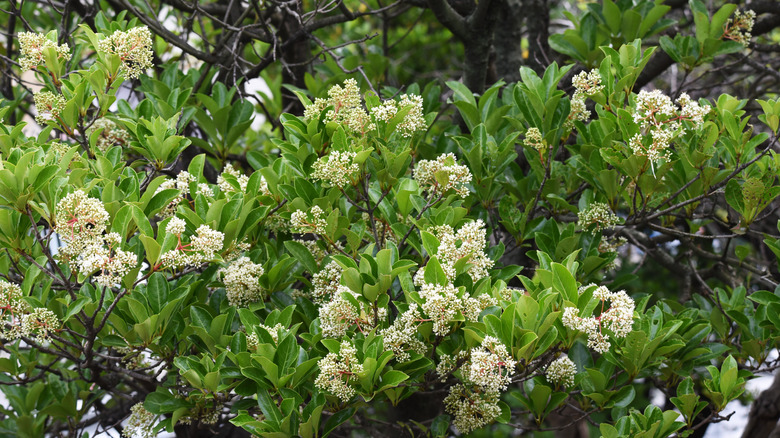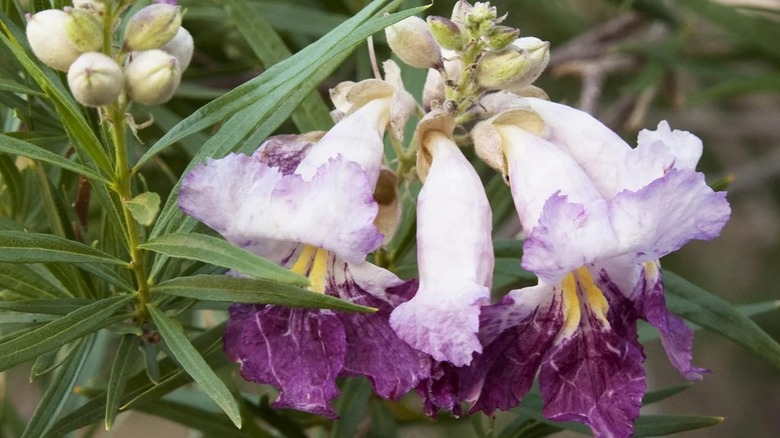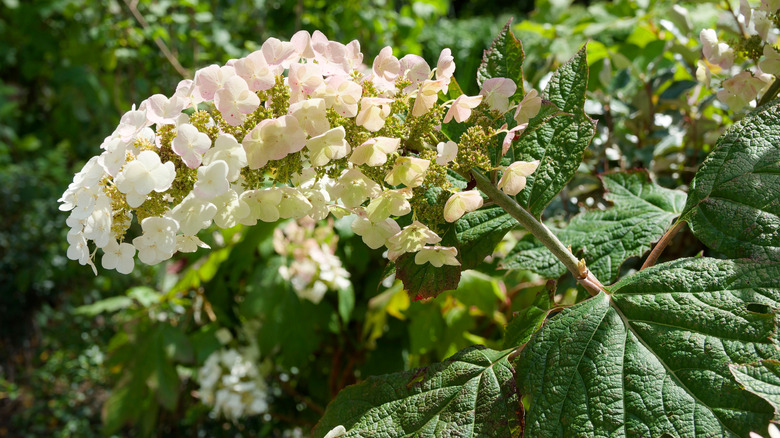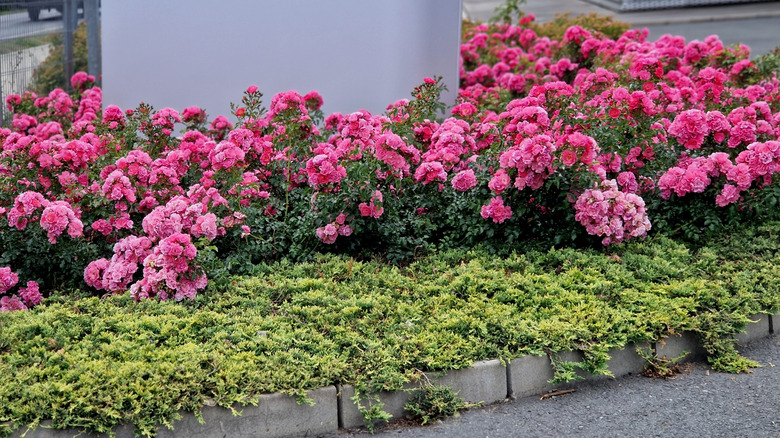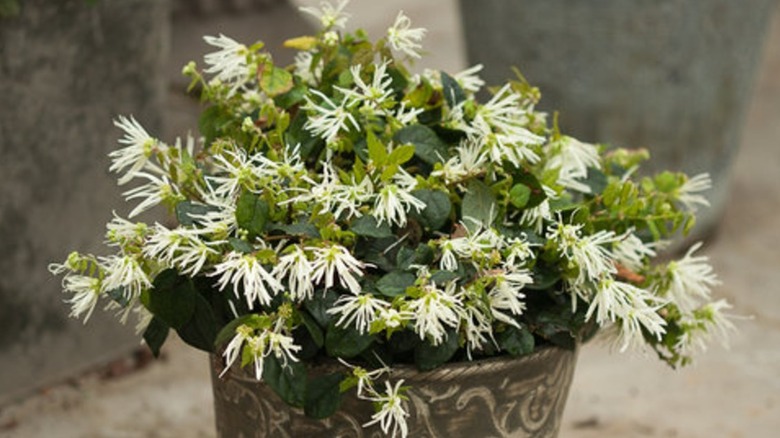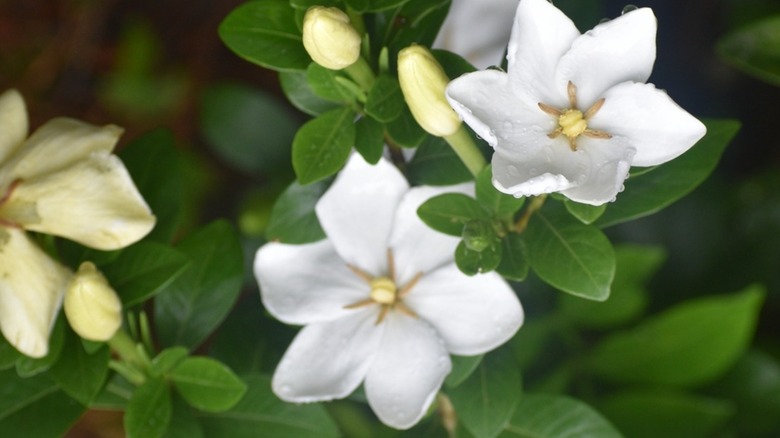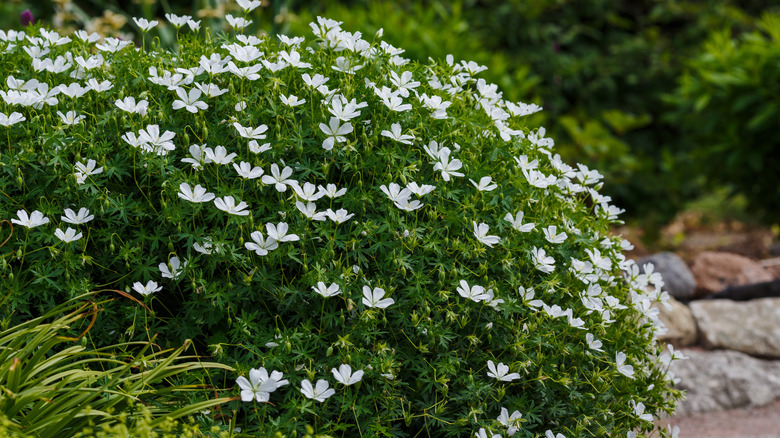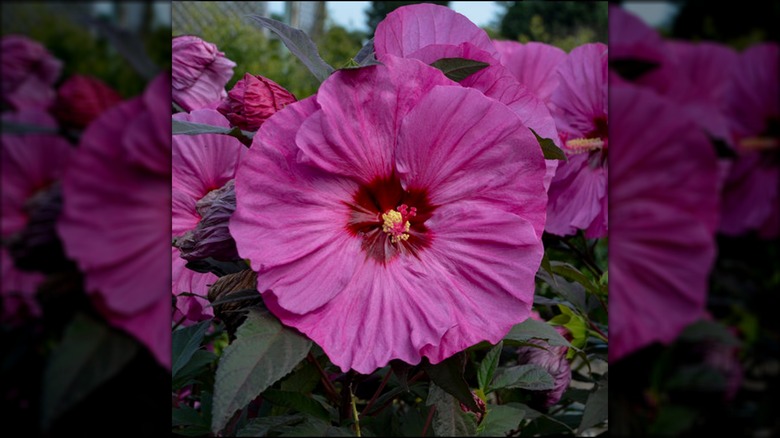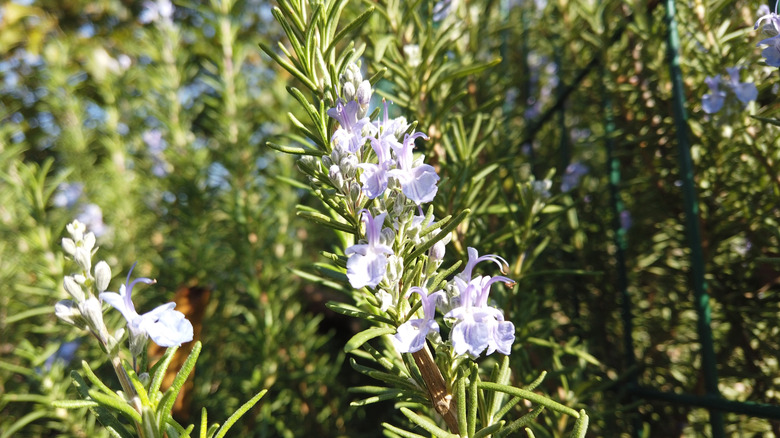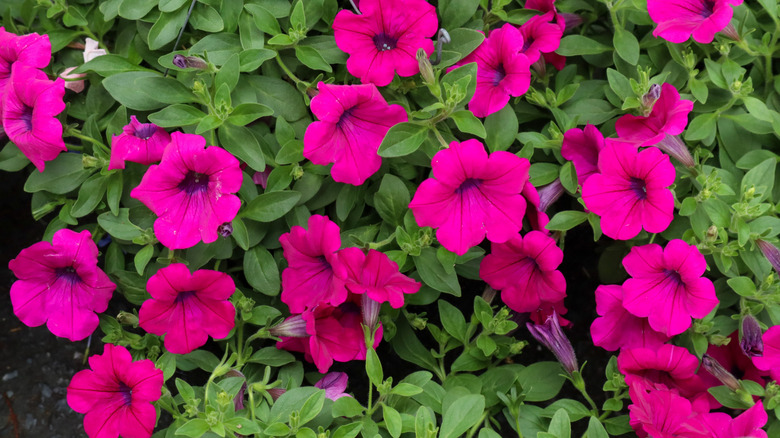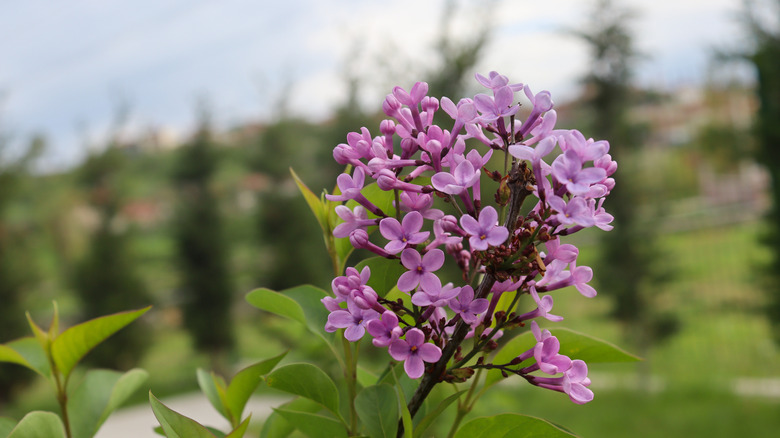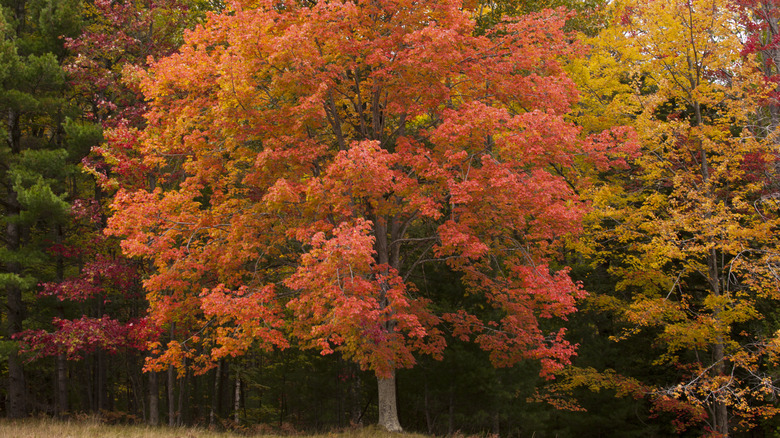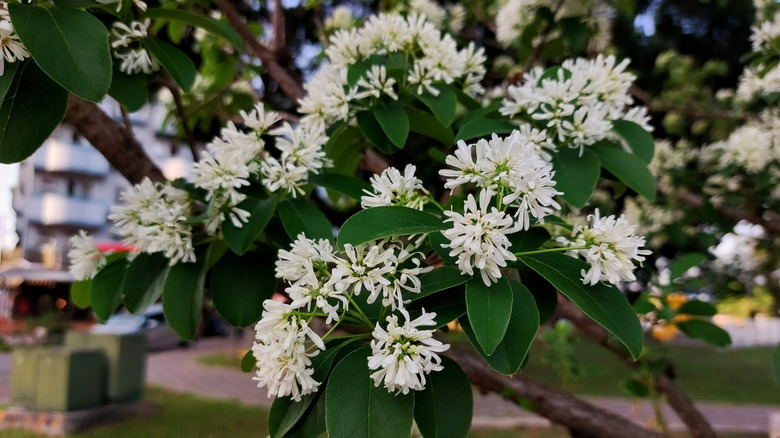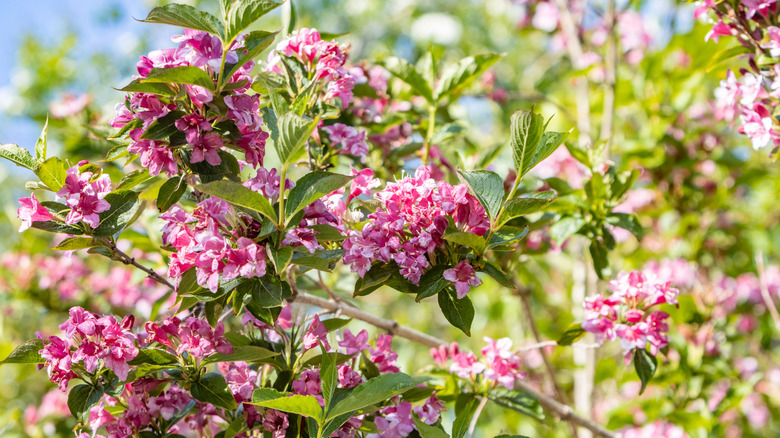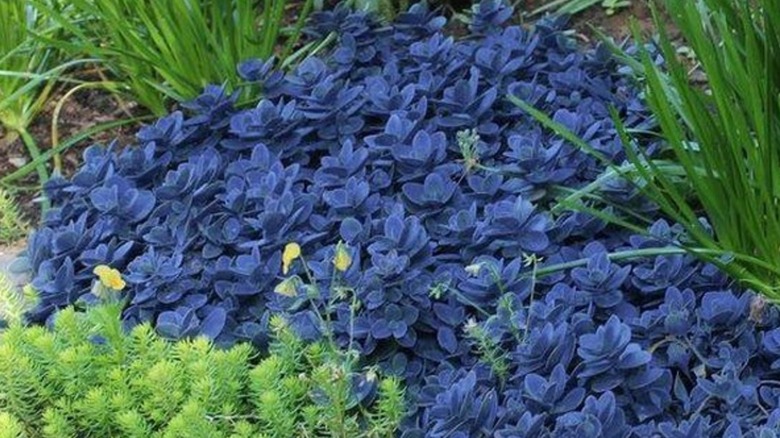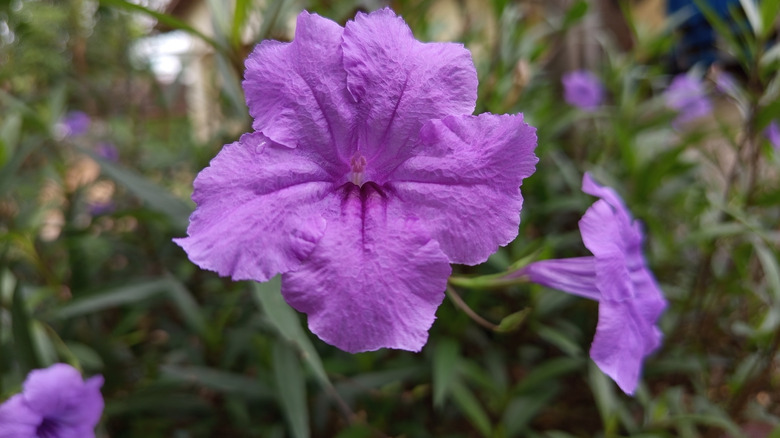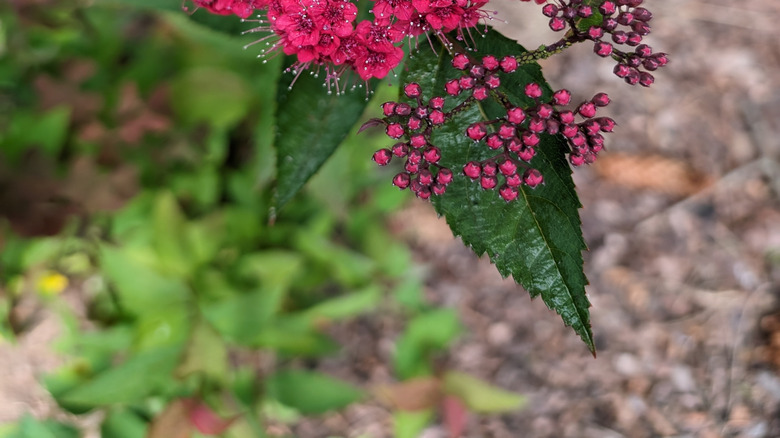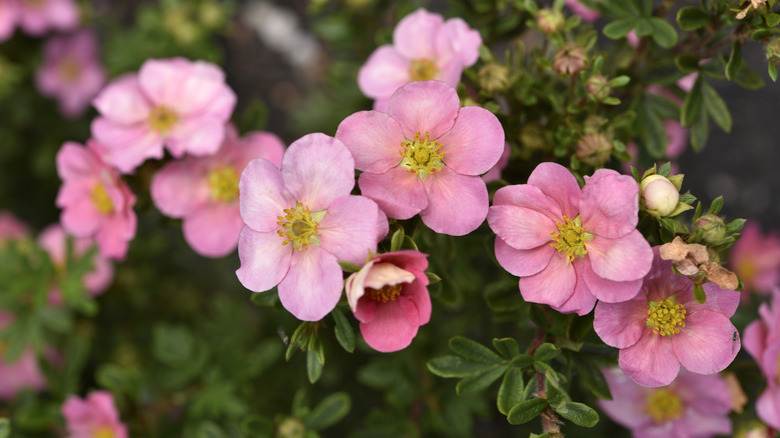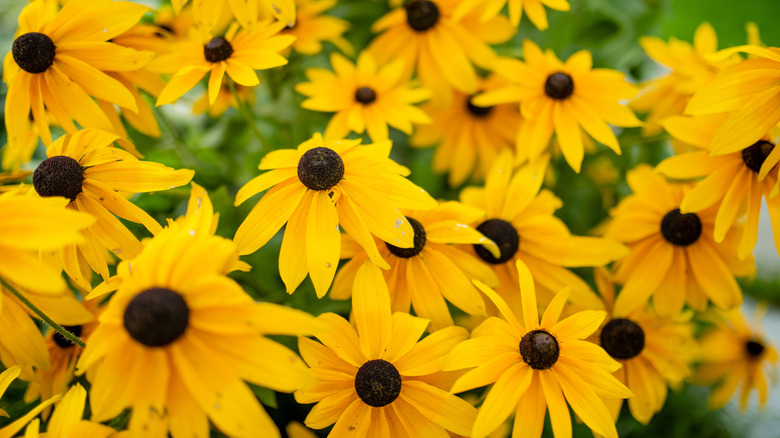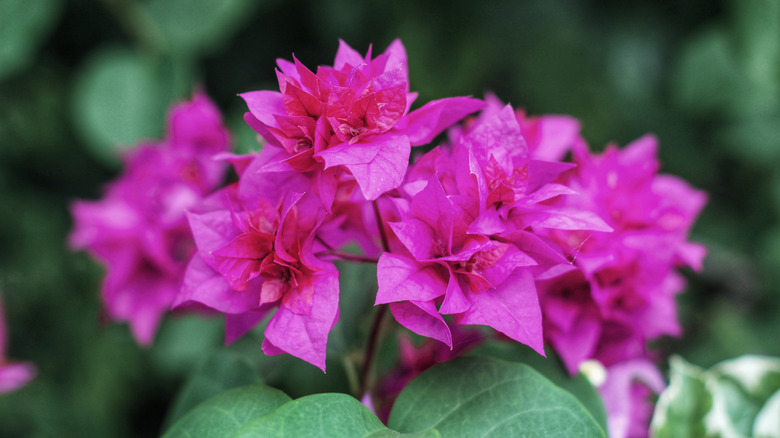Boost Your Home's Value With These 24 Beautiful Front Yard Blooms
When done right, landscaping can raise home value by a significant margin. Typically, homeowners and buyers alike prioritize overall design, adding a heady mix of hardscaping elements and plantings. Plant size can also be important, especially in cold areas where most plants, but especially trees, put out slow growth. But to truly differentiate your home from the neighborly lot, it pays to add distinct plantings to your home that would force anyone driving past to slow down and appreciate your front yard. Since adding several mature evergreens and conifers can get expensive, incorporating gorgeous flowers is an easier way to turn your home front into an absolute showstopper.
Ideally, to maintain an attractive front yard, you must look into a mix of evergreen and deciduous trees and shrubs that provide year-long — or at least multi-season — interest, such as seven-so n-flower, camellias, hydrangeas, azaleas, and roses. You can pair them to frame your entryway and home corners or shear them into flowering hedges and screens. To mark walkways or driveways, look into fragrant flowers — again, with a long or continual blooming season, like sedum or lilacs. In landscape beds and borders, try to incorporate flowering perennials native to your area, or those meeting specific goals such as drought tolerance in water-stressed regions. You may have to minimize your use of annuals as prospective buyers may perceive them as additional expenditure. With the basics established, these are the 24 beautiful blooms you can add to your front yard to boost your home's value.
Camellias
Camellias are a favorite in southern gardens, and for a good reason: They produce some of the most spectacular blooms and animate staid winter landscapes. They look best massed as hedges and screens, though you don't have to limit yourself to a single variety. Instead, extend their flowering season by staggering early, mid-, and late-blooming varieties (like japonica after sansanqua). Alternatively, you can use them as an accent in foundation beds, but protect them from desiccating winds. Since camellias appreciate some shading, they can be grown as understory shrubs. Look for low-maintenance cultivars like 'Autumn Spirit' or 'Kramer's Supreme.'
Glossy abelia
Glossy abelia (Abelia x grandiflora) is a multi-stemmed vasiform shrub that can grow over 6 feet tall and just as wide by maturity. Since it's decked in hummingbird-friendly powderpuff-pink blooms throughout the growth season, it looks striking in the border as a flowering screen or hedge, or even tumbling over retaining walls. Although evergreen in its southern ranges of adaptive zones 5 through 9, it does lose over half of its canopy in cooler climates while remaining attractive because the retained leaves turn a gorgeous red. Plant 'Edward Goucher' to bask in their lovely fragrance. Watch out for aphids.
Encore azaleas
Cold hardy through zone 5 (with mulch and full sun exposure) and south, encore azaleas are sure to grab eyeballs with their show-stopping blooms that profusely swamp the evergreen shrub throughout warm temperatures. After blooming, certain varieties, like Autumn Amethyst and Autumn Sundance, keep the landscape interesting, with leaves turning deeper as the mercury drops with fall. To keep prying eyes out, grow intermediate shrubs like Autumn Royalty or Autumn Sweetheart as flowering hedges that require minimal pruning for shaping. But look for compact options, such as Autumn Chiffon or Autumn Starburst for containers lining walkways or fronting windows.
Sweet viburnum
As its name suggests, sweet viburnum (Viburnum odoratissimum) is a fast-growing flowering shrub that will make your yard smell amazing. Although it doesn't require much pruning, you'll have to occasionally clip off lower limbs for ground clearance and reveal its multi-stemmed habit (unless trained otherwise). Clip the foliage into a narrow-topped formal hedge to show off the spring blooms, or add them to foundation beds as foil for ornamentals. Expect wildlife to visit for the red or black berries. Give it full sun to keep the canopy full and bushy. Sweet viburnums are drought-tolerant after establishment.
Timeless Beauty desert willow
In arid landscapes, desert willows can serve as gorgeous focal points, and Timeless Beauty desert willow (Chilopsis linearis 'Monhews') is one noteworthy selection. It is fire-resistant, highly drought-tolerant, and continuously blooms from spring through summer. Since it doesn't produce seeds, it doesn't get weedy. Plant the weeping specimen to mark entry points or in front of windows where you can view hummingbirds hovering around their perfumed, lavender blooms. You may use Timeless Beauty as a flowering screen to mask unsightly views, including utilities. With full sun, it can tolerate diverse soil conditions, including clay and seasonal flooding.
Oakleaf hydrangea
Oakleaf hydrangeas (Hydrangea quercifolia) spend the better part of spring and summer blooming fragrant flowers atop oak-shaped glossy leaves that grow burgundy in the fall. Even after going leafless in the winter, they remain ornate with cinnamon-showing exfoliating branches. For these reasons, oakleaf hydrangea can be used as your yard's focal point. If massed, HGTV recommends planting this hydrangea for a stunning hedge. These shrubs are drought-tolerant and will look dramatic even in water-wise landscapes. Look for cold hardy cultivars like 'Snowflake,' 'Alice,' or 'Snow Queen,' but if space is premium, grow compact forms like 'Pee Wee' or 'Ruby Slippers.'
Roses
Let's be honest: Front yards are incomplete without roses. You can grow them as groundcovers (think 'Baby Blanket' or 'The Fairy'), as shrub borders and hedges (like the Rosa rugosa group), or have them climbing or rambling down sun-kissed front walls or fences (like 'Sombreuil', 'Golden Showers,' or 'Vielchenblau'). If you hate the upkeep, look for repeat-blooming knock out roses that don't require deadheading and show resistance to major rose diseases. Around walkways, use 'Emily Bronte' or 'Princess Alexandra of Kent' so you may breathe in their fragrance as you amble about. If confused, refer to the American Rose Society's district-wide recommendations for top performers.
Jazz Hands white Chinese fringe-flower
Unlike their name that's quite a mouthful, Jazz Hands white Chinese fringe-flowers (Loropetalum chinense 'Hakuou') are evergreen shrubs with glossy emerald leaves. They burst out white flowers in spring and repeat the show sporadically through the summer. Growing over 5 feet tall, these dwarf beauties can be grown as overstories for flowering perennials in beds and borders. Or, popped in ornate containers to frame landscape edges and paths. They don't require much pruning. However, you'll need to fertilize and water them regularly. Moist, acidic soils are a must. They also have sister varieties with pink blooms.
Frostproof gardenia
If you're worried about foundation shrubs pushing past your top-floor windows, grow Frostproof gardenia (Gardenia jasminoides 'Frostproof'), as its slow-growing 5-foot-frame will remain well-behaved. Not the type to lose its buds to surprise spring frosts, this evergreen beauty can be plopped in perennial beds. Otherwise, you may shear it into a flowering hedge, pot it up, or mass it as a screen and savor its mild fragrance. Camellias and azaleas make great companions. Make sure to get juvenile plants as 'Frostproof' is sensitive to transplantation. Deer and pest-resistant, these summer-blooming beauties do best in part-to-full sun exposure.
Bloody cranesbill geranium
Bloody cranesbill geranium (Geranium sanguineum) will enthrall the bees and butterflies in your yard with its burst of magenta flowers that make their first show in spring. Multiple flushes may follow throughout the summer. Growing wider than tall at 20 inches, this herbaceous perennial will turn burgundy in the fall, with the basal leaves retaining red hues through the winter. Full sun and moist soils bring out the best appearance, though they may tolerate slight shade and clay soils. Plonk them in borders where deer pose problems. Watch out for self-seeding to contain colonization.
Summerific 'Berry Awesome' rose mallow
In wet, swampy yards, consider growing Summerific 'Berry Awesome' rose mallow (Hibiscus hybrid). These compact shrubs may be late to the spring party, but once their black buds unfurl into huge, red-eyed, lavender pink flowers, they steal the show, becoming the talk of the neighborhood. Long-blooming, their profuse show lasts through September in zone 4 and south where their maple-shaped, midnight green foliage is hardy. Site them in perennial or shrub borders as specimens or accents. You may also prop them in containers. Avoid growing hibiscus if Japanese beetles are present in your area.
Rosemary
Deer-resistant, drought-tolerant, and aromatic foliage — what's not to like about rosemary (Salvia rosmarinus)? Blooming lavender or white flowers from spring through summer, rosemary attracts hummingbirds and butterflies to your front yard. However, if you're planting it in containers, avoid potting up, or it might not flower. This 4-foot-tall perennial can be shaped into a topiary for a textural contrast. Highly perfumed cultivars like 'Tuscan Blue' can be sited between windows, while long-blooming trailing types like 'Blue Rain' can be allowed to cascade down a fence or planters. Avoid growing rosemary in humid conditions and clay soils.
Supertunia petunia
Petunias are great but, Supertunia petunias work even better in landscapes, as they bloom through fall. They're self-cleaning, so you don't have to deadhead them. Plus, they come in a diverse range of colors that can fit in with your sensibilities. Go bold with red, pink, or bi-colored varieties, such as 'Black Cherry,' 'Bubblegum,' and 'Pink Star.' Or, for modern homes, stick to garden-neutral colors like deep purple or white present in 'Royal Velvet' or 'Latte.' Grow them in the front of the borders leading up to your porch. Otherwise, pot them in urns placed on your front porch.
Bloomerang lilacs
Bloomerang lilacs set themselves apart from standard specimens in that apart from blooming in spring, they repeat flushes in summer and sometimes even in fall. Most cultivars are available in pink or purple blooms that are well-liked by hummingbirds and butterflies. Consider grouping the 4-foot-tall flowers in foundation beds or grow them as specimens. For containers framing the walkways, look for compact cultivars and enjoy their fragrance. Give them full sun exposure, but protect them from afternoon glaze in hot climates. Rich, fine-draining, alkaline soils are preferred.
Red maple
Although native to the central and east U.S., red maple (Acer rubrum) is adaptive in a wide range, from zones 3 through 9. Despite being deciduous, it becomes a winter highlight due to its exfoliating bark and red flowers that begin blooming toward the season's end. Other highlights include wildlife-friendly samaras and long-lasting fall shades. For reliable color, consider own-root cultivars, such as 'Autumn Flame,' 'Autumn Fantasy,' 'Franksred,' 'October Glory,' 'Red Sunset,' or 'Schlesinger.' As red maple can spread surface roots, give it ample space to grow, or switch to columnar forms like 'Red Rocket,' 'Karpick,' or 'Somerset.'
Seven-son-flower
It might not provide much shade, but seven-son-flower (Heptacodium miconioides) offers copious interest throughout the year. When most plants are going dormant and maples are near-ending their dazzling display, seven-son-flower blooms pale-white flowers, providing a beautiful contrast. These summer flowers make way for purple-red sepals that remain unbothered by cold temperatures, frosts, or light snow. Proven Winner's 'Temple of Bloom' offers consistent color and is available in a trained tree form, though you'll need to selectively prune it to maintain the form. Use it as a specimen or an accent to frame the corners.
Weigela
Jam-packed with rosy-pink blooms in spring, weigela grabs the attention of hummingbirds, delighting onlookers. Since they're deer-resistant, these mid-size shrubs can be grown for privacy or underneath windows. Otherwise, you may site them in borders, foundation beds, or edge plantings to enjoy their summery flushes. However, as weigela grows weepy with age, you'll need to clip the branches to maintain a tidy appearance. Full sun exposure brings out the best blooms, though they tolerate dappled shade. Available in myriad forms, colors, and sizes, you're certain to find cultivars that best fit your aesthetic. 'Sonic Bloom' and 'Wine & Roses' are especially attractive.
Stonecrop Sunsparkler
If you're looking for "plant-and-forget" plants to go up in the hanging baskets suspended on your front porch or the containers outlining walkways, look no further than stonecrop's (Sedum spp.) Sunsparkler series. In addition to their alluringly colorful leaves, these pollinator-friendly perennials produce showy flowers in summer and fall. They survive on little water and are drought-tolerant post-establishment. Where deer hooves are a recurring presence, grow them as groundcovers for some deterrence. Team them with other value boosters like lavender and catmint. Be sure to give sedums proper drainage to avoid rot, or worse, attracting slugs.
Tuberous begonia
Tuberous begonias might not be the easiest plants to grow and may be cold hardy only through zone 9, but they're well worth the effort. Depending on the variety, you may find double or single blooms in sunset colors with ruffled petals that look fantastic in borders. Certain cultivars have blooms matching rose or camellia flowers, presenting teaming opportunities. Their blooming season lasts from mid-summer through fall, though picotee varieties may bloom for four months. You may grow tuberous begonias in containers or hanging baskets, too. They don't like heat and must be sited in dappled or partial shade.
Mandevilla
Are your summers so hot that even tropical flowers can't help but fade? Consider mandevilla, especially in frost-free areas. Full sun lovers, they'll thrive in sultry heat and adapt to diverse soil conditions, as long as they're watered well and fertilized routinely. Their 4-inch-wide pink trumpet flowers look beautiful spilling out from urns or hanging baskets. Since they're vines, you can even train them over mailboxes, though it's best to get compact cultivars like Sun Parasol 'Burgundy.' For fences or arbors, opt for 'Red Velvet' that can stretch over 20 feet. However, don gloves before handling to avoid skin irritation.
Double Play Doozie spiraea
What makes Double Play Doozie spiraea (Spirea hybrid) an absolute statement maker is that it blooms hot pink flowers continuously — sans deadheading — from late spring through frost, feeding bees. Better yet, it doesn't set seeds, which keeps its sprawl in check and makes it suitable for tucking in perennial, foundation beds needing color. Otherwise, you can plant it in multiples of threes for a 3-foot-high mini hedge, provided the area receives six hours of morning light or four hours of afternoon sun. Non-invasive, these spiraea varieties are drought-, deer-, and disease-resistant in zones 3 through 8.
Shrubby cinquefoil
For cold areas (zone 2 and south), shrubby cinquefoil or potentilla (Dasiphora fruticosa) is a suitable planting choice. These easy-maintenance shrubs can withstand drought, salt, alkalinity, soil infertility, and clay with good drainage. Avoid growing them in hot, humid climates of zone 7 and warmer, as they may become prey to mildew and spider mites. Potentilla shrubs have a long blooming season that, starting from spring, can run through fall, making them appropriate as foundation or border plantings receiving full sun exposure. They can also be massed as hedges on sloped yards to check erosion.
Black-eyed Susan
Native to the east U.S., black-eyed Susan (Rudbeckia Hirta) will add immense pollinator value to your foundation plantings or borders; butterflies will fly in for the cheery yellow ray flowers blooming from May through July. You may also find your front yard ringing with chirpy sounds of birds gulping down rudbeckia's seeds that persisted into winter — assuming you've retained a few blooms for self-sowing. Make sure to plant black-eyed Susans in small groups for the best impact. Do note their foliage may take cosmetic damage if your area is visited by silvery checkerspot or emerald butterflies.
Bougainvillea
For those concerned about maintaining a lush yard in drought-stressed locations or looking to create a water-wise landscape, bougainvillea might hold significant value. In full sun exposure, this vining shrub continues to bloom colorful flowers and bracts even if the soil is parched dry. The best part, though? As long as the area is frost-free, you can enjoy the blooms throughout the year. If you want to keep it low-maintenance, simply support the vines over the fence. But if you don't mind some work, pop them into containers and prune them into shrubs or espalier them on a wall.
